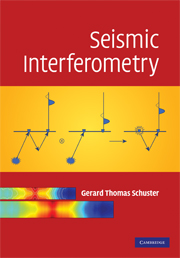Book contents
- Frontmatter
- Contents
- Preface
- 1 Introduction
- 2 Reciprocity equations of convolution and correlation types
- 3 VSP → SWP correlation transform
- 4 VSP → SSP correlation transform
- 5 VSP → SSP convolution transform
- 6 SSP → SSP correlation transform
- 7 VSP → VSP correlation transform
- 8 SSP → VSP → SWP transforms
- 9 Traveltime interferometry
- 10 Stochastic interferometry
- 11 Interferometric source estimation
- 12 Body wave earthquake interferometry
- References
- Index
10 - Stochastic interferometry
Published online by Cambridge University Press: 15 October 2009
- Frontmatter
- Contents
- Preface
- 1 Introduction
- 2 Reciprocity equations of convolution and correlation types
- 3 VSP → SWP correlation transform
- 4 VSP → SSP correlation transform
- 5 VSP → SSP convolution transform
- 6 SSP → SSP correlation transform
- 7 VSP → VSP correlation transform
- 8 SSP → VSP → SWP transforms
- 9 Traveltime interferometry
- 10 Stochastic interferometry
- 11 Interferometric source estimation
- 12 Body wave earthquake interferometry
- References
- Index
Summary
The previous chapters presented the reciprocity-correlation equations for deterministic sources, i.e., the source location or excitation time might be unknown but there is only one point source excited with no vibration overlap from other sources. This means that each band-limited Green's function G(x|B) in the integrand of Equation (2.22) can be individually recorded by exciting a single source at B, e.g. with a VSP experiment, and recording the traces at x. However, passive seismic data are typically generated by a multitude of subsurface sources that generate overlapping vibrations. To account for this cacophony of sounds, the reciprocity-correlation equation is now derived for random wavefields excited by a stochastic distribution of sources and/or scatterers. The sources are assumed to have random phase and amplitude characteristics and their random excitation times can be taken from a Gaussian distribution function. Vibrations from any one source or scatterer temporally overlap the vibrations from the others, and after the energy travels many mean-free times, the intensity begins to decay diffusively, as multiple scattering slows the transport of energy. Paraphrasing from Malcolm et al. (2004):Later, after many mean-free times, the flux of energy out of the region of interest falls to zero even though there is non-zero energy in the medium. This is the equipartitioning regime since the wavefield has no preferred wavenumber and allows for the retrieval of a redatumed Green's function.
Retrieving the Green's function from passive seismic data has many geophysical uses, including redatuming earthquake sources from depth to the Earth's free surface (Claerbout, 1968; Scherbaum, 1987a,b) or redatuming deep sunquake sources to the Sun's surface (Rickett and Claerbout, 1999).
- Type
- Chapter
- Information
- Seismic Interferometry , pp. 189 - 210Publisher: Cambridge University PressPrint publication year: 2009



